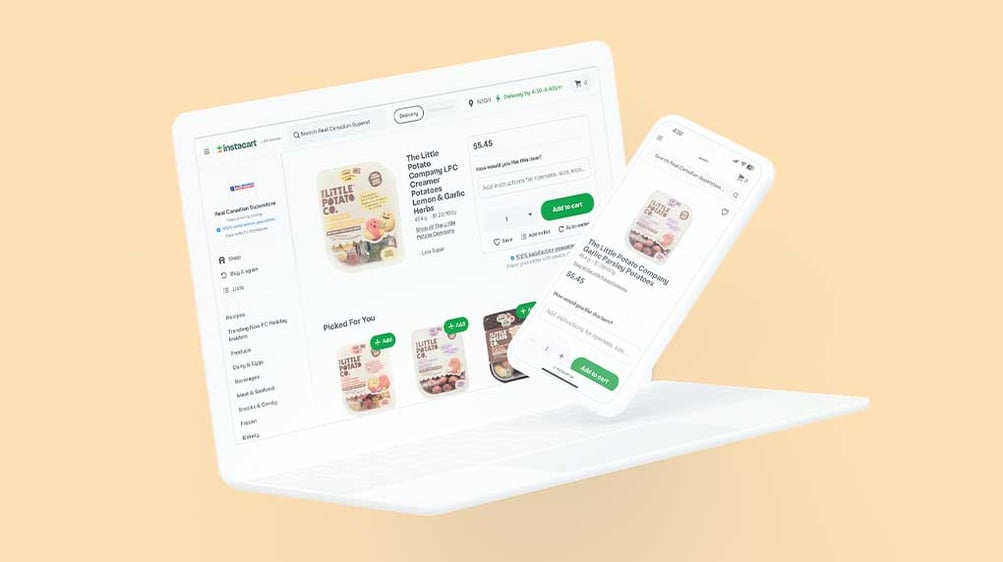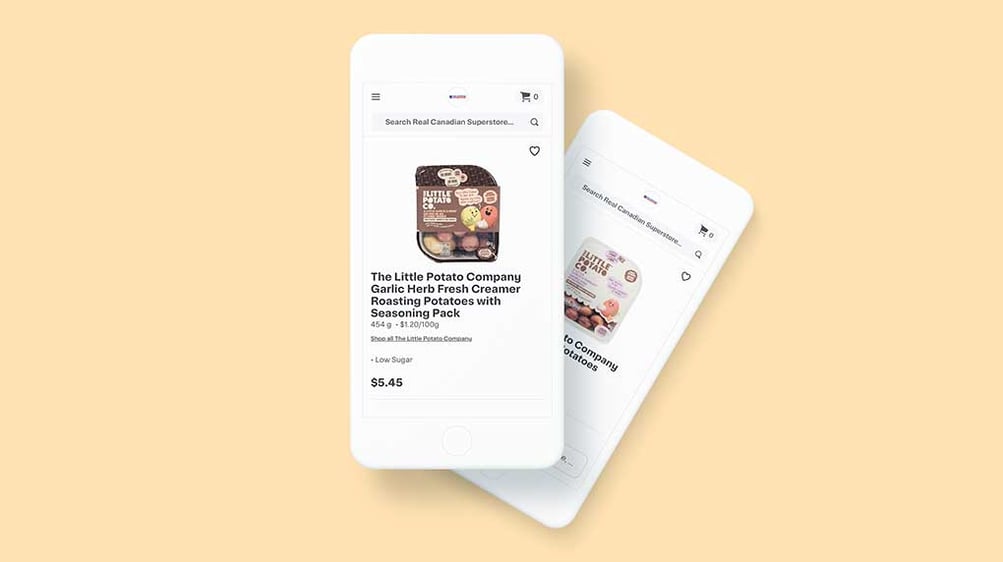As the eCommerce & grocery delivery markets continue to grow for CPG brands, consumers are becoming increasingly savvy about where and how they choose to spend their money.
That means your marketing efforts need to be both creative and effective to reach potential customers — without throwing your budget away on underperforming ads with diminishing returns.
For longtime Major Tom partner The Little Potato Company, the solution was to leverage Instacart - the grocery delivery app powerhouse - as part of their digital campaigns.
With the right strategy for this platform, you can create a multiplier effect on your investments that amplifies even small budgets for dramatic returns. Here, we'll show you how every dollar invested in Instacart marketing can 10x its ROI — setting you up for big growth online.

Target the right audience
Instacart’s online delivery service reaches a broad, but high-intent audience.
Connected with over 75,000 stores and over 900 retail partners across North America, Instacart covers grocery titans like Walmart, Costco, Safeway, IGA, T&T Supermarket, and Loblaws — and even convenience chains like 7-11.
That has led to a massive potential audience for your campaigns on the platform. Their 9.6 million users run the gamut of potential consumers, and roughly:
- 50% are 25-34
- 30% are 50-75
- 80% are women
- 40% are parents
What do they have in common? Almost all of them are on the platform because they’re ready to make a purchase. But there are a few other valuable insights you can draw about the Instacart audience.
First, they’re searching for convenience and willing to pay a premium for it. Research shows that even as consumer spending flags amid recession fears, interest in online orders (both click-and-collect and delivery) has stayed strong, showing the economy's resilience.
Instacart’s platform also offers accessibility for consumers who can’t shop for themselves. That means users who are looking for speed and convenience. They’re likely to be more receptive to products that cater to their needs.
Serve them with the right products
This made Instacart a perfect fit for The Little Potato Company, who offer a premium potato product that’s easy to prep, hassle-free for busy weeknights, and packed full of nutrients.
For convenience-driven Instacart users, The Little Potato Company’s products were the perfect fit.
If you’re looking to start your own Instacart campaign, start by asking which of your products can best cater to that audience - or where to find your specific consumers on the platform - and refine your tactics from there.
Know your ad options — and which is right for you
Once you dig into the Instacart platform, you’ll quickly realize that there are more advertising options than you might have thought.

Sponsored product listings
These are the always-on bread and butter of this channel.
Designed to show off your products throughout users’ journeys on the platform, they’ll appear on the Instacart homepage, in search results, during browsing, and more. You can even set up separate ad groups (with their own maximum CPC bids) within your campaign and serve up the most relevant products to grab their attention.
This is where Major Tom’s work with The Little Potato Company started and formed the foundation for their marketing growth on the platform.
Brand page
Another evergreen option is a Brand Page. Relatively new, this is a dedicated home for your brand on Instacart, which you can treat (and plan) as part of both your brand story and your customers’ user journey.
Adding a brand page is usually an easy decision — since the capability is included free in your Instacart Ads Manager account.
Display and Shoppable Video Ads
Within specific campaigns and shopping seasons, Instacart also offers a variety of Display and Shoppable Video Ads. You can target these by keyword or behavior, like users who shop in your category but might not be aware of your brand. Just remember to review and optimize your approach seasonally, at least, to adjust to changing customer habits.
The shoppable ads also embrace the MISE principle of selling successfully online. They ensure that there are as few clicks as possible between a user noticing your ad and making a purchase.
Finally, don’t forget to leverage Promotions, which entice value-conscious shoppers to follow through and buy.
Whichever tactics you use, build a strong keyword strategy
For any ad type, you’ll need a strong keyword strategy to target the right users and move them down your marketing funnel.
Remember how we called Sponsored Product Listings the bread and butter of your marketing strategy on Instacart? About 80% of your media budget should be going toward these always-on ads — and effective keyword targeting is critical to ensure they drive ROI.
That takes the right balance of competition and search volume and plenty of research, among other concerns. Plus, remember that sponsored product listings will pull from the online retailer information associated with that product listing — so make sure everything is accurate and up-to-date. Your approach can also lean on either optimized bidding or manual bidding, depending on your goals, so be sure you’re clear on campaign objectives before you start allocating your budget. Plus, the right paid media partner will be able to help you hone in on which keywords are performing best.
(Psst — if you have your own online store, it also has an important role to play.)
Your strategy should also include a mix of branded and non-branded keywords, like the brand name, product names, and category-relevant keywords to capture your target audience.
Optimize your campaigns with the “New to Brand sales” metric
As you improve and optimize your Instacart campaigns, this is a crucial number that you’ll want to watch.
The New to Brand metric includes sales from consumers who haven’t purchased from your brand within the last 26 weeks. You can measure it as a dollar sales amount and a percentage of attributable sales.
Why does it matter? Whereas classic metrics like ROAS can help you understand your campaign’s performance in general, New to Brand sales helps you understand what’s driving customer acquisition and growth.
You can separate ad-attributable purchases into existing customers or new-to-brand buyers and refine your targeting and strategy accordingly. It helps you take a more granular approach to future campaigns and double down on what is helping you grow your market share. You can even use these insights to build on plans to nurture and retain existing customers.
Instacart isn’t the only platform that knows how important these numbers are. Last year, Amazon — practically synonymous with online marketplace trends — also introduced the new-to-brand metric to their ad platform.
Build on your Instacart successes for even bigger wins
What sort of results did these tactics deliver for The Little Potato Company? In the months following their Instacart launch, they saw an average ROAS of over 10x.
The Instacart marketing wins didn’t stop there. The Little Potato Company increased its Click-Through Rate (CTR) by 320% — proving that they weren’t just reaching their audience, they were motivating them to act.
Perhaps most importantly, their first Instacart-led campaign increased sales by 51%, and the number of units sold by 39%. It all began with building a strong marketing base on the Instacart app, and evolving their approach from there.
Are you a CPG brand looking to take the next step and drive your own sky-high ROI with Instacart ads? Let's talk about the possibilities.